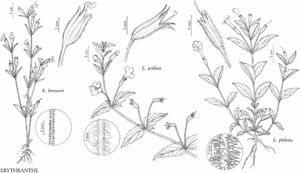Erythranthe breweri
Phytoneuron 2012-39: 36. 2012.
Annuals, taprooted. Stems erect, simple or branched from basal nodes, 2–20 cm, densely glandular-puberulent, hairs 0.05–0.1 mm, gland-tipped. Leaves cauline, basal not persistent; petiole 1–4 mm; blade 1-veined or palmately 3-veined (in broader ones), linear-oblanceolate to linear-lanceolate or linear, (5–) 10–15 (–20) × 1–2 (–5) mm, base attenuate, margins entire or remotely mucronulate distally, apex acute, surfaces densely glandular-puberulent, hairs 0.05–0.1 mm, gland-tipped. Flowers herkogamous, 1–8, from medial to distal nodes. Fruiting pedicels 4–12 mm, densely glandular-puberulent, hairs 0.05–0.1 mm, gland-tipped. Fruiting calyces red-dotted, strongly angled, cylindric-campanulate, 4–7 mm, margins distinctly toothed or lobed, densely glandular-puberulent, hairs 0.05–0.1 mm, gland-tipped, ribs corky, lobes pronounced, spreading. Corollas pink to red, rose red, red-purple, or lavender, throat usually light purple to lavender (similar in color to rest of corolla), palate ridges yellow, abaxial limb with deep pink markings, bilaterally symmetric, strongly bilabiate; tube-throat cylindric-funnelform, 3–7 mm, exserted 0–1 mm beyond calyx margin; limb expanded 2–3 mm, lobes notched or entire. Styles glabrous. Anthers included, glabrous. Capsules included, 3–7 mm.
Phenology: Flowering Jun–Aug(–Sep).
Habitat: Seeps and springs, damp rocks, vernal creek beds, cliffs, granite outcrops, rocky ridges, gravelly areas, meadow edges, stream edges.
Elevation: (700–)1300–3500 m.
Distribution
Alta., B.C., Ariz., Calif., Idaho, Mont., Nev., Oreg., Utah, Wash., Wyo.
Discussion
Selected References
None.
